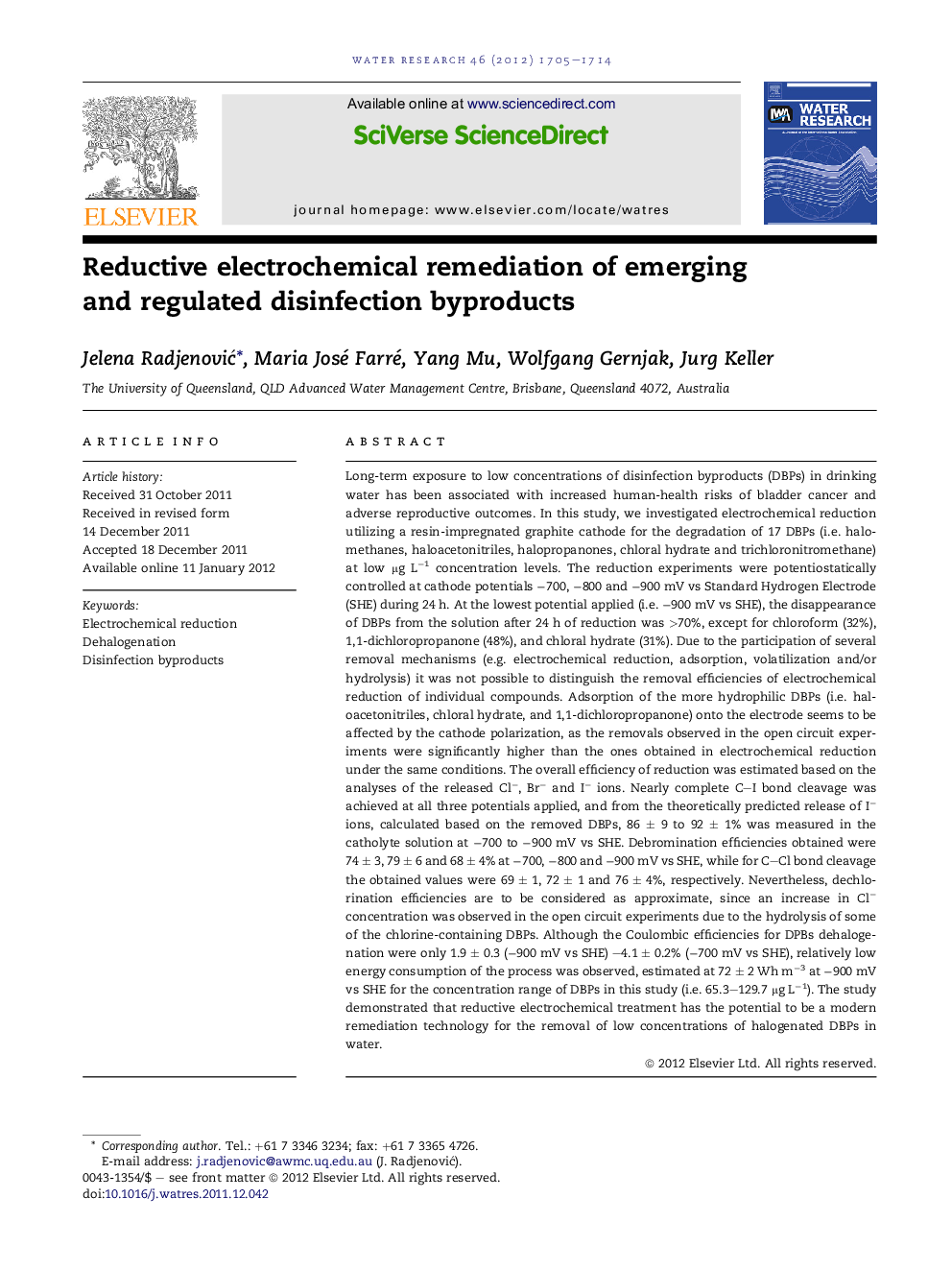| کد مقاله | کد نشریه | سال انتشار | مقاله انگلیسی | نسخه تمام متن |
|---|---|---|---|---|
| 4483469 | 1316889 | 2012 | 10 صفحه PDF | دانلود رایگان |

Long-term exposure to low concentrations of disinfection byproducts (DBPs) in drinking water has been associated with increased human-health risks of bladder cancer and adverse reproductive outcomes. In this study, we investigated electrochemical reduction utilizing a resin-impregnated graphite cathode for the degradation of 17 DBPs (i.e. halomethanes, haloacetonitriles, halopropanones, chloral hydrate and trichloronitromethane) at low μg L−1 concentration levels. The reduction experiments were potentiostatically controlled at cathode potentials −700, −800 and −900 mV vs Standard Hydrogen Electrode (SHE) during 24 h. At the lowest potential applied (i.e. −900 mV vs SHE), the disappearance of DBPs from the solution after 24 h of reduction was >70%, except for chloroform (32%), 1,1-dichloropropanone (48%), and chloral hydrate (31%). Due to the participation of several removal mechanisms (e.g. electrochemical reduction, adsorption, volatilization and/or hydrolysis) it was not possible to distinguish the removal efficiencies of electrochemical reduction of individual compounds. Adsorption of the more hydrophilic DBPs (i.e. haloacetonitriles, chloral hydrate, and 1,1-dichloropropanone) onto the electrode seems to be affected by the cathode polarization, as the removals observed in the open circuit experiments were significantly higher than the ones obtained in electrochemical reduction under the same conditions. The overall efficiency of reduction was estimated based on the analyses of the released Cl−, Br− and I− ions. Nearly complete C–I bond cleavage was achieved at all three potentials applied, and from the theoretically predicted release of I− ions, calculated based on the removed DBPs, 86 ± 9 to 92 ± 1% was measured in the catholyte solution at −700 to −900 mV vs SHE. Debromination efficiencies obtained were 74 ± 3, 79 ± 6 and 68 ± 4% at −700, −800 and −900 mV vs SHE, while for C–Cl bond cleavage the obtained values were 69 ± 1, 72 ± 1 and 76 ± 4%, respectively. Nevertheless, dechlorination efficiencies are to be considered as approximate, since an increase in Cl− concentration was observed in the open circuit experiments due to the hydrolysis of some of the chlorine-containing DBPs. Although the Coulombic efficiencies for DPBs dehalogenation were only 1.9 ± 0.3 (−900 mV vs SHE) –4.1 ± 0.2% (−700 mV vs SHE), relatively low energy consumption of the process was observed, estimated at 72 ± 2 Wh m−3 at −900 mV vs SHE for the concentration range of DBPs in this study (i.e. 65.3–129.7 μg L−1). The study demonstrated that reductive electrochemical treatment has the potential to be a modern remediation technology for the removal of low concentrations of halogenated DBPs in water.
Figure optionsDownload high-quality image (69 K)Download as PowerPoint slideHighlights
► Electrochemical reduction was studied for dehalogenation of disinfection byproducts (DBPs).
► 86 ± 9 to 92 ± 1% of the theoretically predicted I- ions were released from DBP molecules.
► Debromination efficiencies were 74 ± 3, 79 ± 6 and 68 ± 4% at −700, −800 and −900 mV vs SHE, respectively.
► Efficiencies of C–Cl bond cleavage were 69 ± 1 - 76 ± 4%, indicating incomplete dechlorination.
► The observed release of halides indicated electrochemical cleavage of carbon-halide bonds.
Journal: Water Research - Volume 46, Issue 6, 15 April 2012, Pages 1705–1714